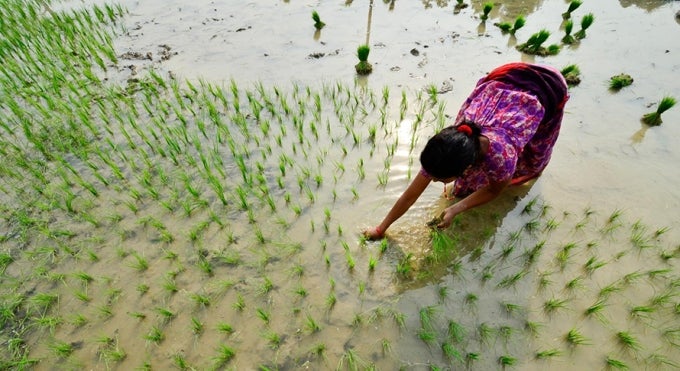
According to a recent study published in Science Advances, climate change is projected to hit South Asia especially hard.
Impacts will be particularly intense in the food and agriculture sector. A region inhabited by about one-fifth of the world’s people, South Asia and its densely populated agricultural areas face unique and severe natural hazards. Its food system is particularly vulnerable. Climate-smart agriculture (CSA)-- which is an integrated approach to managing landscapes that is focused on increasing agricultural productivity, improving resilience to climate change, and reducing agricultural greenhouse gas emissions—is part of the solution.
The World Bank is working to mainstream climate smart agriculture in South Asia with a series of Climate-Smart Agriculture or “CSA” Country Profiles for Bhutan, Nepal and Pakistan, that were launched recently in collaboration with Governments and relevant stakeholders. The findings in the profiles are specific to national contexts, but there is a common thread. We learned that for South Asia, climate change adaptation and mitigation pose major challenges and opportunities for agriculture sector investment and growth.
The farmers, Government representatives and other stakeholders I met during the CSA Country Profile launches expressed huge interest in learning how they can put CSA into practice. Farmers especially were interested in making CSA part of their daily farming routines. As interest grows, so does momentum to take the CSA agenda forward, from research institutions and high level gatherings into farmer’s fields. As one farmer I met in Pakistan said, “Climate-smart agriculture is Common-sense agriculture.”
Pakistan
Climate change is already impacting Pakistan, which often experiences periods of severe droughts, followed by devastating floods. In the aftermath of the 2010 floods, one fifth of the country’s land area was submerged, damaging the economy, infrastructure and livelihoods, and leaving 90 million people without proper access to food. Moving forward, changes in monsoons and increased temperatures will further challenge the agricultural sector, particularly northern Pakistan where vulnerability to climate change is already high.
At the same time, CSA offers attractive opportunities for strengthening Pakistan’s agricultural sector. Innovative, technological practices like laser land leveling and solar powered irrigation systems and management changes like crop diversification, proper cropping patterns and optimized planting dates could put Pakistan’s food system onto a more climate-smart path. Investments in research to develop high-yielding, heat-resistant, drought-tolerant, and pest-resistant crop varieties as well as livestock breeds could also make a difference.
Nepal
For Nepal, climate projections suggest rising mean annual temperatures, a faster warming of the country’s western regions, changes in precipitation during the monsoon period (with variations from -14 to 40%) as well as the increased likelihood of heavy precipitation events and flooding. Changes in precipitation patterns are likely to affect rain-fed agricultural activities, which account for a significant portion of the food Nepalese citizens eat.
What steps can Nepal’s farmers take to improve their prospects in a changing climate? Techniques to increase overall farm productivity such as intercropping and the use of drought-tolerant and high-yielding varieties of staple crops like lentils could help boost harvests and ultimately, feed more people. Since irrigation is so critical to Nepal’s farmers, more efficient water management approaches such as drip-irrigation can improve long-term sustainability. Finally, since dairy and livestock is a major source of food, farmers should increase production, processing and storage of more fodder crops to feed livestock, as well as implement stall feeding to improve nutrient management. These actions can go a long way towards helping livestock farmers improve productivity and reduce deforestation.
Bhutan
In recent years, Bhutan has experienced rapid changes in average temperatures and precipitation patterns, as well as increased risks of climate hazards such as excessive rains, flash floods, windstorms, hailstorms, and droughts. This has caused massive losses and damage to farming households, especially since farmers are entirely dependent on the monsoons for irrigation. The late arrival of the monsoon can lead to drought, while excessive monsoon rains can cause landslides and floods.
So what actions can Bhutan take to get on a more climate-smart path? Farmers are advised to use pest and drought-resistant varieties of maize and rice, which are two of Bhutan’s staple crops. Practices like intercropping as well as alternate wetting and drying of paddy rice can also help Bhutan’s farmers remain productive, even in the face of increasing climate-hazards. Finally, using quality feed for cattle and expanding the use of biodigesters can help ensure that Bhutan’s dairy farmers continue to meet Bhutanese citizens’ dairy needs in a sustainable way.
These CSA profiles are one important step among many toward helping scale up climate-smart approaches to agriculture in Pakistan, Nepal, and Bhutan. Moving forward there is an urgent need to ensure that Governments put in place enabling policies and effective extension services to ensure that lessons and guidance from these profiles reach all stakeholders—especially the farmers who are on the frontlines of the food system, and provide strong incentives for putting these into practice.


Join the Conversation